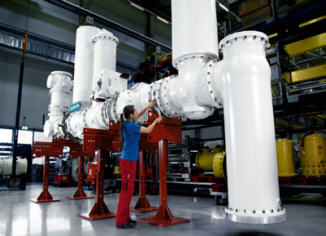|
Siemens presents first gas-insulated 320-kV switchgear
for direct current
transmission
• Compact gas-insulated switchgear requires 95 percent
less space
compared to air-insulated unit
• Helps substantially reduce
costs in the offshore realm
• Cornerstone of the new direct current
transmission portfolio
based on gas-insulation technology
At the
Cigré conference in Paris, Siemens presented the first compact
gas-insulated switchgear (GIS) for high-voltage direct current
applications. Within the framework of the energy transition, high-voltage
direct current (HVDC) transmission is gaining in significance as it allows
low-loss transmission of large amounts of electricity over long distances.
The new 320-kilovolt (kV) gas-insulated switchgear uses up to 95 percent
less space compared to previous air-insulated units. When used on an
offshore platform, the platform size can thus be decreased by
approximately 10 percent.
The efficient HVDC transmission
technology is necessary to bring wind power generated in the North Sea to
load centers in southern Germany, for example. For this, 155 kV of
alternating current (AC) from wind power is converted on a converter
platform into 320 kV of low-loss direct current (DC) and then transmitted
to land via submarine cables. When transmitting electricity, the general
rule is that the higher the voltage, the less power lost. Once on land, a
converter station converts the direct current back into alternating
current for further distribution.
The direct current switchgear
that is part of the converter station currently uses air-insulated
technology and thus requires a large amount of space. Because of air’s
relatively low insulating capability, the individual components can only
be installed with a large amount of space between them and also between
them and the earth potential. The air-insulated DC switchgear that has
been used on Siemens’ converter platforms until now requires about 4,000
cubic meters of space, thereby requiring halls that are from two to ten
meters high. However, space is a decisive cost factor both out at sea as
well as in urban population centers. The innovative, compact DC CS (Direct
Current Compact Switchgear) has the same capacity but needs only 200 cubic
meters, thereby allowing space savings of up to 95 percent.
“With
the 320-kV DC CS switchgear’s market readiness, we have laid a cornerstone
for the development of a completely new portfolio for efficient power
transmission. Space-saving direct-current transmission solutions will
continue to grow in significance in the future,” explained Denis Imamovic,
head of development for gas-insulated direct current transmission systems
at Siemens. “We believe that the DC CS switchgear will establish itself as
the standard for offshore converter platforms and thereby play a major
role in decreasing costs for HVDC transmission grid connections.”
In addition to the small size, the newly developed switchgear has other
advantages. Its module-based design makes the DC CS especially flexible
and simple to set up, and enables the use of cost-efficient shipping and
transportation methods. Because all current-carrying parts are fully
encapsulated, the system can also be reliably installed under demanding
environmental conditions, such as on the high seas or near the coast, and
it does not necessarily have to be housed in a building. Furthermore, the
compact switchgear offers maximum reliability and low maintenance costs.
The DC CS systems are manufactured in Siemens’ Berlin switchgear
production plant.
While gas-insulated, three-phase current
switchgear has been part of Siemens’ portfolio for decades, there had not
been a corresponding gas-insulated technology for direct current
applications to date. Since controlling an electric field under direct
current is very complex, it had not been possible until now to build
gas-insulated, compact DC switchgear for HVDC transmission applications.
The development of a new isolator, which can permanently withstand the
demands of high-voltage direct currents, made it possible to develop the
first DC GIS switchgear. A pilot station based on 320-kV direct-current
components that simulates the connection of an offshore wind farm to the
grid is currently being run through a long-term test.
DC CS systems
and the associated service are part of Siemens’ Environmental Portfolio.
Around 43 percent of its total revenue stems from green products and
solutions. That makes Siemens one of the world’s leading providers of
eco-friendly technology.
Source: Sabrina
Martin, Siemens AG, www.siemens.com
|

Worldwide more than
90,000 paid subscriptions

Worldwide
more than 48,000 subscriptions -
100% one-year direct request
qualification

'What's New' in Upstream, Midstream and
Downstream Products & Services. Circulation 37,000
PennWell
Petroleum Group:
Oil & Gas Journal
Oil & Gas Journal Russia
OGJ_eNewsletter
OGJ-Website-Statistics
Oil, Gas & Petrochem Equipment
Offshore Magazine
Offshore
Russia
Offshore eNewsletter
Offshore
Website Statistics
Oil & Gas Financial Journal
+ + +
For more information, media
kits or
sample copies please contact
Andreas
Sicking
+49 (0)2903-338570
wilhelms@pennwell.com
www.sicking.de
|


